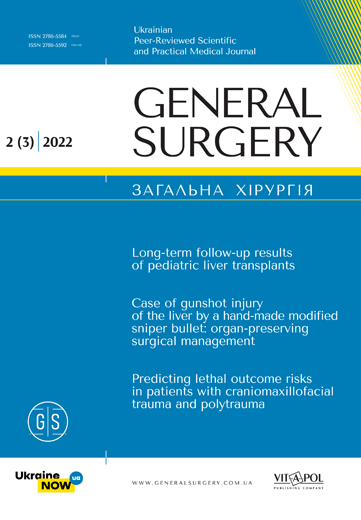Latissimus dorsi flap (LD-flap) or endoprosthesis for breast reconstruction? Which is optimal for immediate reconstruction after a nipple-sparing mastectomy in breast cancer patients?
DOI:
https://doi.org/10.30978/GS-2022-2-48Keywords:
breast cancer, reconstruction with LD flaps, reconstruction with endoprosthesis, nipple‑sparing mastectomyAbstract
The article analyzes two methods of breast reconstruction: breast reconstruction with an implant or an LD‑flap after a subcutaneous nipple‑sparing mastectomy in the case of complex treatment of stage I — III breast cancer. In many works, the advantages and disadvantages of different types of reconstruction are indicated and contradictions can often be found, although most prefer reconstruction with implants.
Objective — to compare the results of immediate breast reconstruction using an implant or an LD‑flap after a subcutaneous nipple‑sparing mastectomy in patients with I — III stages of breast cancer.
Materials and methods. We conducted a comparative study of the results of immediate reconstruction of the mammary gland after a subcutaneous nipple‑sparing mastectomy using the method of putting a silicone implant (endoprosthesis) or the method of LD‑flap reconstruction. Randomization was not carried out. The results of operative interventions were retrospectively and parallelly compared in two groups: reconstruction of the mammary gland with an implant (1) or LD flap (2). In both groups of 30 patients, all patients were diagnosed with stage I — III breast cancer and in most cases (80 — 83 %) received preoperative chemotherapy for regression and reduction of the stage of the process. The evaluation of the treatment result was carried out according to aesthetic indicators, oncological survival indicators, and the subjective evaluation of the aesthetic result by patients.
Results. During the observation period since 2018, the analysis of the frequency of development in the groups of relapses and metastases during the 4‑year observation period (since 2018), the frequency of development of local complications in both groups: hematomas, skin necrosis, implant extrusions, seromas, lymphorrhea, capsular contractures, liponecrosis, lymphostasis of the upper extremity on the side of the operation, the degree and duration of the pain syndrome in the postoperative area, and the possibility of a full course of treatment did not show significant differences during the observation period. The quality of life in both groups, according to the Spitzer scale, was comparable (in the first group, 64 %, and in the second group, it was 63 %). Only the duration of postoperative bed rest was longer in the LD flap reconstruction group.
Conclusions. The results of the analysis of the study’s data showed that there are advantages and disadvantages to both methods. According to the findings, it is difficult to conclude which of the methods is more optimal, but it is necessary to choose the technique based on the constitutional characteristics of the patient and the size and shape of the mammary gland. An individualized and comprehensive approach is important.
References
Breast Cancer. NCCN Clinical Practice Guidelines in Oncology. Version 2.2019. https://www.nccn.org/professionals/physician_gls/pdf/breast.pdf.
Cancer stats facts: female breast cancer. National Cancer Institute. Accessed April 7, 2021. seer.cancer.gov/statfacts/html/breast.html.
Naoum GE, Salama L, Niemierko A, et al. Single stage direct-to-implant breast reconstruction has lower complication rates than tissue expander and implant and comparable rates to autologous reconstruction in patients receiving postmastectomy radiation. Int J Radiat Oncol Biol Phys. 2020;106:514-24.
Broyles JM, Balk EM, Adam GP, et al. Implant-based versus Autologous Reconstruction after Mastectomy for Breast Cancer: A Systematic Review and Meta-analysis. Plast Reconstr Surg Glob Open. 2022 Mar 11;10(3):e4180. doi: 10.1097/GOX.0000000000004180. eCollection 2022 Mar.PMID: 35291333.
Saldanha IJ, Broyles JM, Adam GP, et al. Autologous Reconstruction after Mastectomy for Breast Cancer. Plast Reconstr Surg Glob Open. 2022 Mar 14;10(3):e4181. doi: 10.1097/GOX.0000000000004181.
Azouz V, Lopez S, Wagner DS. Surgeon-controlled comparison of direct-to-implant and 2-stage tissue expander-implant immediate breast reconstruction outcomes. Ann Plast Surg. 2018;80:212-6.
Su CL, Yang JR, Kuo WL, Chen SC, Cheong DC, Huang JJ. Direct-to-implant breast reconstruction following nipple-sparing mastectomy: predictive factors of adverse surgical outcomes in Asian patients. Arch Plast Surg. 2021 Sep;48(5):483-93. doi: 10.5999/aps.2021.00374. Epub 2021 Sep 15.
Gao P, Bai P, Ren Y, Kong X, Wang Z, Fang Y, Wang J. Biological matrix-assisted one-stage implant-based breast reconstruction versus two-stage implant-based breast reconstruction: patient-reported outcomes and complications. Aesthetic Plast Surg. 2021 Dec;45(6):2581-90.
Pek WS, Tan BK, Ru Ng YY, et al. Immediate breast reconstruction following nipple-sparing mastectomy in an Asian population: aesthetic outcomes and mitigating nipple-areolar complex necrosis. Arch Plast Surg. 2018;45:229-38.
Colwell AS, Christensen JM. Nipple-sparing mastectomy and direct-to-implant breast reconstruction. Plast Reconstr Surg. 2017;140:44S–50S.
Schain WS, Wellisch DK, Pasnau RO, et al. The sooner the better: a study of psychological factors in women undergoing immediate versus delayed breast reconstruction. Am J Psychiatry. 1985;142:40-6.
Seidel W, Bins-Ely J, Ongaratto Barazzetti D, et al. Breast reconstruction after mastectomy for breast cancer: comparative analysis of early and delayed reconstruction. Minerva Chir. 2017;72:188-99.
Colwell AS, Tessler O, Lin AM, et al. Breast reconstruction following nipple-sparing mastectomy: predictors of complications, reconstruction outcomes, and 5-year trends. Plast Reconstr Surg. 2014;133:496-506.
Offodile AC II, Gu C, Boukovalas S, et al. Enhanced recovery after surgery (ERAS) pathways in breast reconstruction: systematic review and meta-analysis of the literature. Breast Cancer Res Treat. 2019;173:65-77.
Cortina CS, Patten CR, Adamson K, et al. Enhanced Recovery After Surgery (ERAS): protocols in post-mastectomy breast reconstruction. Curr Breast Cancer Rep. 2020;12:398-404.
Terkawi AS, Tsang S, Sessler DI, et al. Improving analgesic efficacy and safety of thoracic paravertebral block for breast surgery: a mixed-effects meta-analysis. Pain Physician. 2015;18(5):E757-E780.
Kasimahanti R, Arora S, Bhatia N, Singh G. Ultrasound-guided single- vs double-level thoracic paravertebral block for postoperative analgesia in total mastectomy with axillary clearance. J Clin Anesth. 2016 Sep;33:414-21.
Gschwantler-Kaulich D, Leser C, Salama M, et al. Direct-to-implant breast reconstruction: higher complication rate vs cosmetic benefits. Breast J. 2018;24:957-64.
Krishnan NM, Fischer JP, Basta MN, et al. Is single-stage prosthetic reconstruction cost effective? A cost-utility analysis for the use of direct-to-implant breast reconstruction relative to expander-implant reconstruction in postmastectomy patients. Plast Reconstr Surg. 2016;138:537-47.
Downloads
Published
How to Cite
Issue
Section
License
Copyright (c) 2022 Authors

This work is licensed under a Creative Commons Attribution-NoDerivatives 4.0 International License.






